
“I feel like a chicken with its head cut off,” Kirstie Ennis says from her home in Glenwood Springs, Colo. Though it’s only noon, she’s already completed a flurry of work, knocking out meetings with a fundraising partner, a veteran’s advocacy group, and then confirming her Mount Everest date for next year.
If that’s not enough, she’s still recovering from the most recent surgeries on her leg and face. For anyone counting, those were operations No. 47 and 48, all since the 2012 helicopter crash in southern Afghanistan, where she served as a marine door gunner and helicopter mechanic. The injuries for the then-21-year-old sergeant were extensive, including her face and spine, on top of a traumatic brain injury. The most severe injury was her left leg, which was amputated above the knee.
A year later, she began snowboard racing in the Paralympics, and in 2015, walked 1,000 miles through Great Britain to honor 25 fallen marines and raise awareness for Walking with the Wounded. Her physical rebound and exploits garnered serious media attention, notably on the 2017 cover of ESPN The Magazine’s Body Issue and featured in both People and Outside, which calls her “the toughest mountaineer on earth.” Today, Ennis, originally from Pensacola, Fla., is the documentary subject of Standing Tall (initially called The Art of Suffering), which follows her first, 2019 attempt on Everest, the final peak in her quest to complete the Seven Summits.
Through the six years-long project to climb the highest mountain on each of the Earth’s seven continents, Ennis realized the service potential of such deeply personal challenges that yielded media attention: The expeditions could work to raise both awareness and funds. The obvious recipient was nonprofits seeking to assist other fellow, disabled veterans in journeys to discover the benefits of the outdoors. Cue the formation of the Kirstie Ennis Foundation in 2018, which now formally provides that support for partners working toward healing in the outdoors, education, and therapy clinics. Beyond founding her own nonprofit, Ennis is also a spokesperson for other like-minded groups while sitting on the boards of multiple other organizations—all working with a common vision pointed outdoors.
And that’s often where you’ll still find Ennis, as tackling the Seven Summits comes with a loaded travel schedule: Mount Kilimanjaro in Tanzania; Mount Elbrus in Russia; Denali in Alaska; Aconcagua in Argentina, which she calls “brutal”; Vinson Massif in Antarctica; Carstensz Pyramid (Puncak Jaya) in Oceania; and, the finale of Everest on the border of Nepal and Tibet. But the effort isn’t self-serving. “It’s about raising awareness,” she says, “fundraising, and working with local communities around the world.”
Kilimanjaro, for instance, was for the nonprofit Waterboys, where professional athletes help bring water to those in need, and Carstensz Pyramid for the Heroes Project, which provides physical and emotional support to wounded veterans. Public Lands sat down recently with Ennis to ask a few more questions about why she advocates so wholly for outdoor experiences. In some ways, she says, it’s not about the activity itself, whether it’s snowboarding, mountain biking, or even climbing: “It’s just to be able to set a precedent and provide people the confidence to explore these same things.”
%20-%20draft_1?qlt=95&ts=1692039215484&dpr=off)



